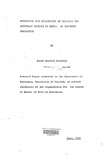| dc.description.abstract | Human resource problems are many* But the common ones can
broadly be categorized into two* First, those rocusing on the
underdevelopment of human skills, knowledge and talents: and
second problems, that arise from underutilization of human
capabilities for those already in the working force* Each of
these problems can be broken down into several aspects of major
economic concern* This study seeks to address itself to the
*
second category of problems. In particular, the study focuses on one category of manpower, teachers for secondary schools in relation to their utilization rates in service and the extent to which they are retained in the profession once produced*
The study begins by examining tjje growth of the secondary school education and the expansion of teacher education with reference to the capacities of the training institutions. It goes further to hypothesize that there are no teacher production constraints and that the problems facing the education sector are those related to misallocation, underutilization and attrition of teachers.
Contending with the crucial difficulties of measuring human utilization capacities, the study used teacher "contact periods" per a five-day working week as a proxy for capacity utilization. However, teacher utilization extends outside classwork a phenomenon which was acknowledged but not included due to nonavailability
of data. Teacher utilization rates were measured
and compared between different categories of teachers based on the teachers* school location (urban or rural), subject specialization
and level of qualification.
An analysis of the magnitude and trend of teacher attrition was also done over a period between 1973 and 1984. Two aspects of attrition that the study focused on were resignations and dismissals and were also classified into teachers' level of qualification.
The major findings included the acceptance of the general hypothesis that teacher production in Kenya is not constrained. But, the' problems the education system faces1 are those of:
(i) Underutilization of teachers which varied from the teachers' school location, level of qualification and subject specialization.
UO- Massive attrition of. teachers from the profession, though this showed a falling trend over time.
The general causes of these two problems stem from the administration inefficiencies, in particular the-action of the Teachers Service Commission; and the working of the economic indicators in the labour market to which labour units respond. These cause artificial shortages of teachers and geographical imbalances. Then, arising from these findings, the study makes suggestions for policy regarding teacher analysis in the country. These suggestions included:
(i) the calculation of teacher requirements based on.the curriculum rather than on teacher-student ratio;
(it) giving incentives to rural based teachers to solve the geographical imbalance of teacher distribution; ini) teacher postings should be done systematically
involving school headteachers who should identify the existing teaching posts to avoid misallocation and underutilization; and,
Uv) teaching should be made more professional by making scholarships available only to those students who are willing and determined to be teachers, and also that the teaching profession should be made more competitive in the labour market so as to hold
down attrition rates | en_US |



